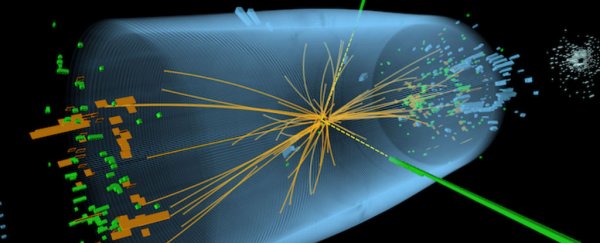The results of a new investigation into strange flashes of light picked by the Large Hadron Collider (LHC) back in December have just been announced at a conference in Italy, and physicists are getting cautiously excited that they could be the signs of new particle that could break the standard model of physics.
While further experiments are still needed to confirm if this apparent excess of photons really is evidence of a new particle, the fact that no one's been able to disprove what physicists have seen hints that we could be close to discovering something extraordinary. "If this thing turns out to be real, it's a 10 on the Richter scale of particle physics," physicist John Ellis from King's College London, and the former head of theory at CERN, told The Guardian. "One's excitometer gets totally broken."
Before you all set your own excitometers to "Holy crap!", let's run through what just happened here, because while these could be the signs of something huge afoot, they could also be nothing - just the craziest of statistical coincidences.
"I would love for it to persist, but I've seen so many effects come and go that I have to say in my heart of hearts I'm not very optimistic," says Ellis. "It would be such a fantastic discovery if it were true, precisely because it's unexpected, and because it would be the tip of an iceberg of new forms of matter."
Back in December, physicists were abuzz with news that the LHC's two main detectors, Atlas and CMS, had both seen the same small 'blips' in their data that could not be explained by our current understanding of the laws of physics.
When protons were smashed together inside these massive detectors, the reaction had produced slightly more high-energy photons (light particles) than our best theories of physics predict, Ian Sample explains at The Guardian.
Specifically, both the CMS and ATLAS detectors recorded a spike in activity at a particular energy level, corresponding to around 750 giga electronvolts (GeV) - or roughly 750 billion electron volts.
Found hidden in the debris of these proton-proton collisions, this unexplained signal could be the sign of a new particle that resembles the Higgs boson, only it'd be around 12 times heavier, with a mass of 1,500 GeV, teams of physicists analysing the data announced last year.
At the time of the discovery, some physicists were referring to the hypothetical new particle as Higgs boson's heavier cousin. Others think the light blips could signify that the Higgs boson itself is made up of a bunch of smaller particles.
Or perhaps these were signs of the existence of a graviton - an hypothesised force-carrying particle for gravity. "That would be truly remarkable: so far, gravity has proved impossible to reconcile with theories of other particles and forces," says Sample.
They were exciting results, and since December, more than 200 papers have been published discussing what they could possibly mean, but it's going to take a whole lot more than similar blips in two detectors for us to determine if this is 'real' evidence of a new particle, or simply a statistical error.
Put simply, the physicists behind the experiments probably wouldn't have even mentioned it if it hadn't turned up in both detectors.
"When all the statistical effects are taken into consideration … the bump in the Atlas data had about a 1-in-93 chance of being a fluke - far stronger than the 1-in-3.5-million odds of mere chance, known as 5-sigma, considered the gold standard for a discovery," Dennis Overbye wrote for The New York Times back in December. "That might not be enough to bother presenting in a talk, except for the fact that the competing CERN team, named CMS, found a bump in the same place."
Now, three months later, the CMS and ATLAS teams have gone over their data with a fine-toothed comb, and presented the results of their latest analyses at a particle physics conference in Italy last week.
After collecting additional data, and recalibrating the December results over and over, both teams cannot discount the anomaly as a statistical error, which is good news for everyone hoping that this is the start of something big. The bad news is that they still can't explain it, and they still need a whole lot more proof before we can call this a "discovery".
Interestingly, while the excess of photons picked up by the CMS experiment has now become slightly more significant, thanks to the results of the new analysis, the significance seen by ATLAS actually declined, leaving many to ponder what that actually means.
As Davide Castelvecchi and Elizabeth Gibney report for Nature, the new analysis of the the statistical significance of the CMS bump has now gone up from 1.2 to 1.6 sigma, while ATLAS's statistical significance now sits at 1.9 sigma after corrections.
Sample says the chance of a 1.9 sigma effect being a fluke is the same as flipping a five heads in a row - hard, but not impossible. According to the rules of science, you can't say something's a discovery until you hit that 5-sigma mark - the same as tossing 21 heads in a row.
We're now left playing the waiting game once again, but not for long. The LHC will be woken up from its winter hibernation over the next week, and will be up and running again by the end of April, which means more proton-proton collisions, and a whole lot more data for the ATLAS and CMS teams to prove or disprove their results.
As Castelvecchi and Gibney write for Nature, "by June, or August at the latest, CMS and ATLAS should have enough data to either make a statistical fluctuation go away - if that's what the excess is - or confirm a discovery", and we can't wait. Watch this space.
